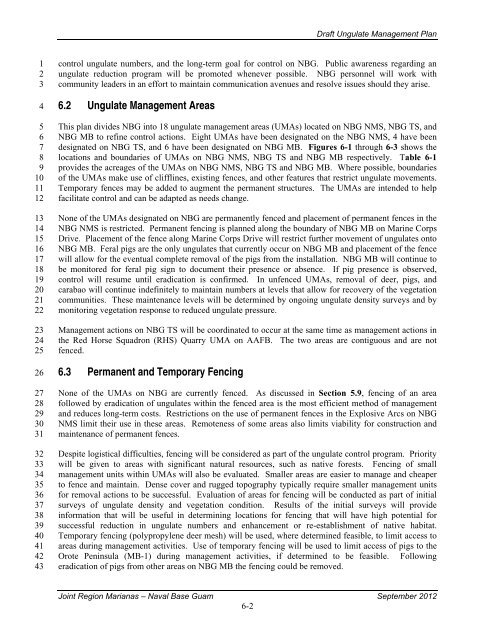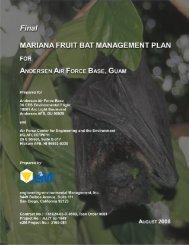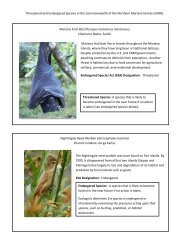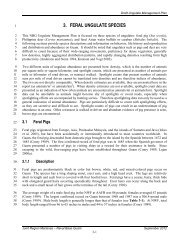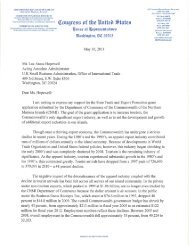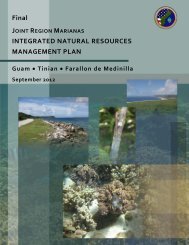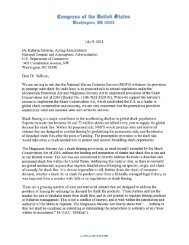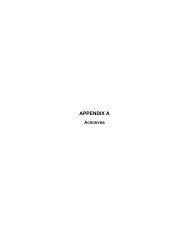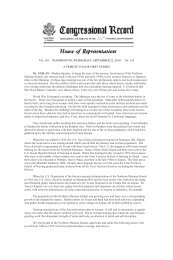4. FERAL UNGULATE SPECIES IMPACTS ON NAVY LANDS
4. FERAL UNGULATE SPECIES IMPACTS ON NAVY LANDS
4. FERAL UNGULATE SPECIES IMPACTS ON NAVY LANDS
You also want an ePaper? Increase the reach of your titles
YUMPU automatically turns print PDFs into web optimized ePapers that Google loves.
1<br />
2<br />
3<br />
4<br />
5<br />
6<br />
7<br />
8<br />
9<br />
10<br />
11<br />
12<br />
13<br />
14<br />
15<br />
16<br />
17<br />
18<br />
19<br />
20<br />
21<br />
22<br />
23<br />
24<br />
25<br />
26<br />
27<br />
28<br />
29<br />
30<br />
31<br />
32<br />
33<br />
34<br />
35<br />
36<br />
37<br />
38<br />
39<br />
40<br />
41<br />
42<br />
43<br />
Draft Ungulate Management Plan<br />
control ungulate numbers, and the long-term goal for control on NBG. Public awareness regarding an<br />
ungulate reduction program will be promoted whenever possible. NBG personnel will work with<br />
community leaders in an effort to maintain communication avenues and resolve issues should they arise.<br />
6.2 Ungulate Management Areas<br />
This plan divides NBG into 18 ungulate management areas (UMAs) located on NBG NMS, NBG TS, and<br />
NBG MB to refine control actions. Eight UMAs have been designated on the NBG NMS, 4 have been<br />
designated on NBG TS, and 6 have been designated on NBG MB. Figures 6-1 through 6-3 shows the<br />
locations and boundaries of UMAs on NBG NMS, NBG TS and NBG MB respectively. Table 6-1<br />
provides the acreages of the UMAs on NBG NMS, NBG TS and NBG MB. Where possible, boundaries<br />
of the UMAs make use of clifflines, existing fences, and other features that restrict ungulate movements.<br />
Temporary fences may be added to augment the permanent structures. The UMAs are intended to help<br />
facilitate control and can be adapted as needs change.<br />
None of the UMAs designated on NBG are permanently fenced and placement of permanent fences in the<br />
NBG NMS is restricted. Permanent fencing is planned along the boundary of NBG MB on Marine Corps<br />
Drive. Placement of the fence along Marine Corps Drive will restrict further movement of ungulates onto<br />
NBG MB. Feral pigs are the only ungulates that currently occur on NBG MB and placement of the fence<br />
will allow for the eventual complete removal of the pigs from the installation. NBG MB will continue to<br />
be monitored for feral pig sign to document their presence or absence. If pig presence is observed,<br />
control will resume until eradication is confirmed. In unfenced UMAs, removal of deer, pigs, and<br />
carabao will continue indefinitely to maintain numbers at levels that allow for recovery of the vegetation<br />
communities. These maintenance levels will be determined by ongoing ungulate density surveys and by<br />
monitoring vegetation response to reduced ungulate pressure.<br />
Management actions on NBG TS will be coordinated to occur at the same time as management actions in<br />
the Red Horse Squadron (RHS) Quarry UMA on AAFB. The two areas are contiguous and are not<br />
fenced.<br />
6.3 Permanent and Temporary Fencing<br />
None of the UMAs on NBG are currently fenced. As discussed in Section 5.9, fencing of an area<br />
followed by eradication of ungulates within the fenced area is the most efficient method of management<br />
and reduces long-term costs. Restrictions on the use of permanent fences in the Explosive Arcs on NBG<br />
NMS limit their use in these areas. Remoteness of some areas also limits viability for construction and<br />
maintenance of permanent fences.<br />
Despite logistical difficulties, fencing will be considered as part of the ungulate control program. Priority<br />
will be given to areas with significant natural resources, such as native forests. Fencing of small<br />
management units within UMAs will also be evaluated. Smaller areas are easier to manage and cheaper<br />
to fence and maintain. Dense cover and rugged topography typically require smaller management units<br />
for removal actions to be successful. Evaluation of areas for fencing will be conducted as part of initial<br />
surveys of ungulate density and vegetation condition. Results of the initial surveys will provide<br />
information that will be useful in determining locations for fencing that will have high potential for<br />
successful reduction in ungulate numbers and enhancement or re-establishment of native habitat.<br />
Temporary fencing (polypropylene deer mesh) will be used, where determined feasible, to limit access to<br />
areas during management activities. Use of temporary fencing will be used to limit access of pigs to the<br />
Orote Peninsula (MB-1) during management activities, if determined to be feasible. Following<br />
eradication of pigs from other areas on NBG MB the fencing could be removed.<br />
Joint Region Marianas – Naval Base Guam September 2012<br />
6-2


